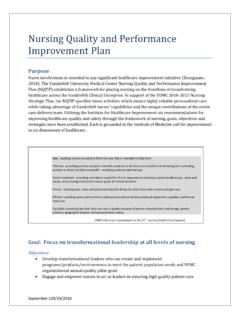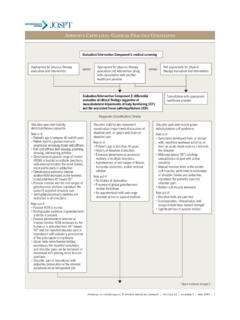Transcription of Prevention of Falls in Older Persons: AGS/BGS Clinical ...
1 Prevention of Fallsin Older Persons: AGS/BGS ClinicalPractice GuidelineTABLE Background Selection of Evidence Structure of the Guideline Grading the Strength of Recommendations Goal AND ASSESSMENT Algorithm Algorithm to PREVENT Falls Older Persons Living in the Community Older Persons in Long-Term Facilities Older Persons with Cognitive ImpairmentACKNOWLEDGMENTS Panel members and affiliationsAPPENDICES Appendix A:Evidence Tables Appendix B: Evidence Grading System Appendix adults are at higher risk of falling than younger individuals, and are more likely to sustainan injury as the result of a fall. (Campbell et al., 1990; Rubenstein et al., 2002). Falls are not onlyassociated with greater morbidity and mortality in the Older population, but are also linked toreduced overall functioning and early admission to long-term care facilities. (Brown et al.)
2 , 1999;Rubenstein et al., 1994; Tinetti,1986). Reducing fall risk in Older individuals is therefore animportant public health objective. (Sattin,1992) Prevention of Falls in Older Persons: AGS/BGS Clinical Practice GuidelinePage2 The Guideline for the Prevention of Falls in Older Persons, a joint endeavor of the AmericanGeriatrics Society, theBritish Geriatrics Society, and the American Academy of OrthopaedicSurgeons, was published in May, 2001. (JAGS 2001) The aim of the Guideline was to assisthealth care professionals in their assessment of fall risk and in their management of Older adultswho have fallen or are at risk of falling. The present publication offers an update to the earlierguideline by evaluating evidence and analyses that have become available since 2001 and byproviding revised recommendations based on these community residents, effective fall Prevention has the potential to reduce serious fall-related injuries, emergency department visits, hospitalizations, nursing home placements, andfunctional decline.
3 Evidence from randomized controlled trials and other types of studiessupporting the beneficial effects of fall Prevention programs has done little to change the lack ofattention to fall risk in Clinical practice. A recent study confirmed that effective fall riskassessments and strategies to prevent Falls can significantly reduce serious injuries (hip and otherfractures, head injuries, joint dislocations) as well as use of fall-related medical services. (Tinetti,2008)Multifactorial assessment coupled with tailored interventions based on the assessment findingscan have a dramatic public health impact while improving quality of life in the Older multidisciplinary panel that developed this Update was led jointly by representatives of theAmerican Geriatrics Society and the British Geriatrics participants includedmembers of the American Academy of Orthopaedic Surgeons, the American Board of InternalMedicine, the American College of Emergency Physicians, the American Geriatrics Society, theAmerican Medical Association,the American Occupational Therapy Association, the AmericanPhysical Therapy Association, the American Society of Consultant Pharmacists, the BritishGeriatrics Society, the John A.
4 Hartford Foundation Institute for Geriatric Nursing at New YorkUniversity, and the National Association for Home Care and Hospice. The panel met in one face-to-face meeting, and thoroughly evaluated the content and validity of each section of the updatein a series of subsequent conference calls. An experienced moderator facilitated these resulting Update is the product of many months of discussion and consensus building. Thisfinal document has been reviewed and approved by all organizations participating in the of Falls in Older Persons: AGS/BGS Clinical Practice GuidelinePage3 Selection of EvidenceThe panel collected evidence via a three-step process. First, an experienced researcher carriedout a literature search to identify meta-analyses, systematic literature reviews, randomizedcontrolled trials, controlled before-and-after studies, and cohort studies published between May2001 and April 2008 (Note1).
5 The researcher also examined reference lists of included articles,and utilized the expert knowledge and experience of panel members to locate additional addition to Medline/PubMed, the following databases were searched: Database of Abstracts ofReviews of Effectiveness, Centre for Reviews and Dissemination/Health TechnologyAssessment, and the Cochrane Central Register of Controlled Trials. For Medline/PubMedsearches, the investigator utilized a combination of subject heading and free text searches withthe following search terms: Falls , fallers and time to first fall. Limits were set for language(English), type of research (randomized controlledtrial, systematic review including HealthTechnology Assessment review, Clinical trial, controlled Clinical trial, and meta-analysis) and age>65 years. Intermediate outcome studies, inpatient or hospital studies, and studies of fractureoutcomes were search selected evidence from original Clinical trials that a)provided sufficient detail regarding methods and results to enable use and adjustment of the data;and b) allowed relevant outcomes to be abstracted from the data presented in addition to studies identified by these methods, a number of seminal studies published prior toMay, 2001, were also included if more recent updates in these areas of research or analysis werenot yet available.
6 In the second stage of the search process, three panel members performed atitle review of the collected publications and requested abstracts from relevant randomizedcontrolled trial reports. The review of abstracts and the exclusion/inclusion process identified 91studies that met the the final evaluation stage, full texts of the included studies were retrieved and abstracted toevidence tables. The abstracted data and the full texts were made available to the members of thepanel during the development of the and evaluation process allowed panel members to comprehensively summarize thelast decade of evidence regarding the risk of falling and the interventions that have beenPrevention of Falls in Older Persons: AGS/BGS Clinical Practice GuidelinePage4investigated for the purpose of reducing Falls in Older , because definitions ofinterventions differ from study to study, and are often not clearly elaborated, the panel chose toemphasize outcomes from individual studies rather than stressing the results of panel did, however, refer to five recentmeta-analyses and evidence-based guidelines in have excluded discussion of interventions aimed at bone health ( , medications forosteoporosis), and have chosen not to address the topics of syncope, restraints, bone protection( , hip protectors), or in-patient hospital-based fall Prevention .
7 Syncope in the context of fallsis fully addressed in the 2004 European Falls Guidelines (Brignole, 2004).Because the guideline is intended to assist health care providers, we have excluded discussion ofpopulation-based we have focused on fall Prevention in community-domiciled Older adults for this update, we have also provided specific recommendationsconcerning two subgroups: Older persons in long-term care and Older persons with of the GuidelineThe Clinical algorithm describes the step-by-step process of decision-making and interventionthat should occur in the management of persons who present in a Clinical setting with recurrentfalls or difficulty walking, or in the emergency department after an acute andspecific recommendations for each point in the algorithm are included in the annotations sectionfollowing the algorithm. The links to these recommendations areembedded in each relevant stepof the annotations include a brief discussion of the research supporting the recommendations.
8 Mostalso present the rationale behind the grading of the evidence as well as a determination of thestrength of therecommendations. The Evidence Tables list the studies that were considered inmaking decisions regarding the level of evidence for each recommendation. These tables arepreceded by Evidence Statements in which information from a selection of the most relevantstudies is provided in order to highlight key issues in the research of Falls in Older Persons: AGS/BGS Clinical Practice GuidelinePage5 For some interventions, outcome data were insufficient to allow evidence-basedrecommendations to be made, or the existing literature was ambiguous or conflicting. In thesecases, the panel made recommendations based on consensus after intensive the Strength of RecommendationsA standardized format based on an evidence rating system used by the PreventativeServices Task Force was used to critically analyze the literature and grade the evidence for thisdocument.
9 (Harris et al., 2001)In this approach, the grade for the strength of a recommendationdepends on the overall quality of evidence and on the magnitude of net benefit. The panelmembers rated the overall quality of evidence using the terms shown in Appendix B, benefit (benefit minus harm) was rated as substantial, moderate, small, or zero ornegative as described in Appendix B, Table on these determinations of overall qualityof evidence and magnitude of benefit for each intervention, the panel assigned a grade for eachrecommendation using the definitions in the following table:Table 1. Strength of Recommendation Rating SystemAA strong recommendation that theclinicians provide the intervention to eligible evidence was found that the intervention improves health outcomes and theconclusion is that benefits substantially outweigh recommendation that clinicians provide thisintervention to eligible least fair evidence was found that the intervention improves health outcomes andtheconclusion is that benefits outweigh recommendation for or against the routine provision of the intervention is fair evidence was found that the intervention can improve health outcomes.
10 But thebalance of benefits and harms is too close tojustify a general is made against routinely providing the intervention to least fair evidence was found that the intervention is ineffective or that harm is insufficient to recommend for or against routinely providing the thatthe intervention is lacking, orof poor quality, or conflicting, and thebalance of benefits and harms cannot be on the Preventive Services Task Force rating system (Harris et al, 2001)Note1:The panel reviewed the RCTs published between April 2008 and July 2009 and concluded thatthe additional evidence did not change the ranking of the evidence or the guidelinePrevention of Falls in Older Persons: AGS/BGS Clinical Practice GuidelinePage6recommendations. Of note, the negative RCTs of multifactorial interventions all involved riskfactor assessment with referral without direct intervention or ensuring that the interventions optimize assessment and interventions for reducing the number of Falls in statement of the Guideline Working GroupThe panel anticipates that these guidelines will provide a stimulus for widespread use ofeffective, evidence-based fall Prevention services for Older awareness of thebenefits of such Prevention will also increase leadingto more demand for fall Prevention servicesby Older adults and their advocates.



